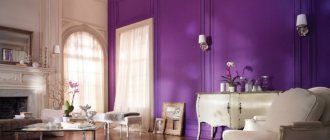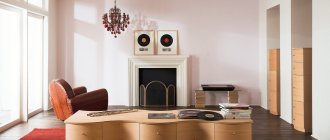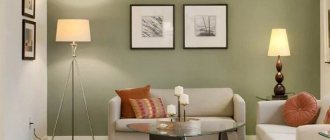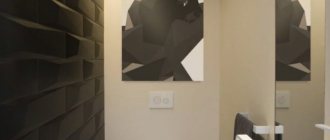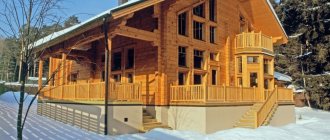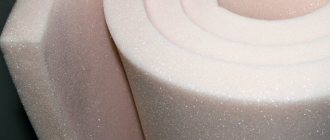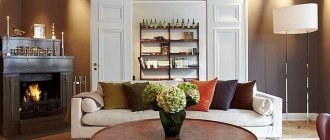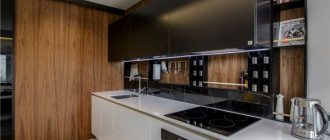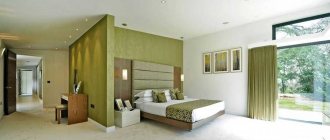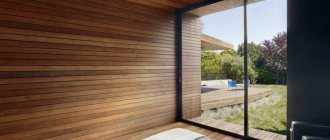Types of plastic panels according to method of application
Today there are different plastic panels. Sizes and prices also differ. It all depends on the type of material. So, PVC panels can be:
- wall;
- ceiling
Some of the types of this material may be universal.
There are also some other differences. There are the following plastic wall panels based on the method of covering the surface:
- supporting;
- tall.
Ceiling panels can only be basic. They are also used for wall decoration.
The dimensions of plastic panels for walls, which are used in the main decoration of the room, are:
- length – 2.5-3 m;
- width – 1-1.5 m;
- thickness – 0.8-1 cm.
Support plastic panels have the following parameters:
- width – 1-1.5-2 m;
- length – 1-1.3 m.
It is worth considering that the sizes of plastic panels for the ceiling differ from those for the walls. They have a length from 2.5 to 4 m. The width reaches 10-50 cm. The most common parameters in the design of the ceiling surface are panels 25 cm wide and 4 m long.
PVC panels: dimensions and general properties of the material
Polyvinyl chloride panels (PVC), despite their relatively recent appearance on the market, have already managed to win the attention of consumers, especially those who are planning to carry out home renovations themselves.
This popularity of the material is due to many factors:
- favorable technical and operational characteristics;
- an extensive assortment (various types of products differing from each other in color, quality, texture, cost);
- simple installation system.
The characteristics of plastic panels allow them to be used in many types of premises
Thanks to the wide selection of sizes of PVC plastic panels, this type of finish is considered universal. The assortment includes products designed for walls and ceilings, as well as panels that are suitable for finishing a certain type of room.
General types and sizes of PVC panels for ceilings and walls
The modern range of products offered by the market can be roughly divided between several groups. Highlight:
- tile-type polyvinyl chloride panels;
- lining;
- sheet products.
In each group, there are differences between PVC plastic panels: sizes, prices, level of rigidity, weight. Dimensional and other parameters of the lamellas depend on the group in which they are included. This may have an impact on the design of the bathroom, kitchen or bathroom, as well as on finishing work that involves treating the ceiling or walls in other rooms.
The optimal width of panels for wall decoration is 50-60 cm
The standard parameter for the thickness of the lamellas is in the range of 0.5-1 cm. This indicator is very important to take into account if you plan to purchase molding. Molding is an overhead decorative strip used as a finishing element and decoration in the interior.
If we talk about PVC wall panels, the dimensions of these materials allow the products to be distributed between two groups. One of them includes panels whose thickness is 0.5 cm. The second group includes lamellas with a thickness in the range of 0.8-1 cm. Despite such a wide range, for panels from the second group moldings are made in a single universal size.
Buying a 3-meter long PVC ceiling panel today is not difficult, since this size is included in the standard line of parameters.
General dimensions of PVC panels (standard):
| Product type | Standard width, m | Standard length, m |
| Slatted panel | 0,13-0,3 | 0,9-3 |
| Wall panel | 0,15-0,5 | 2,6/2,7/3 |
| Tile panel | 0,3/0,98 | 0,3/0,98 |
| Sheet panel | 0,5-1,22 | 0,98-2,44 |
Types of panels by connection type
PVC lamellas on the market for finishing walls and ceilings may have different types of connections. Based on this, the range of panels can be divided into several groups:
- products with a relief surface;
- seamless;
- products that have a chamfer (rust).
Seamless plastic panels are in most cases used for finishing the ceiling surface. As a result of installation, the products are located very tightly to each other, due to which the size of the seams is minimal. If the technology is followed, it is possible to achieve an effect in which the connecting line between adjacent elements will be practically invisible.
Seamless plastic panels allow you to create continuous patterns in the decoration of walls or ceilings
Panels with a chamfered connection have many similarities with seamless lamellas. The only difference is the presence of this chamfer in the end part of the product. Rust is a decorative recess used to connect PVC panels into a single sheet. Beveled lamellas, or rusticated panels as they are also called, can be used both for finishing walls and ceilings.
Rectangular products with a relief surface are more suitable for installation on walls. In terms of external characteristics, they have similar features to lining. The relief finish stands out from other PVC panels due to its high strength and wear resistance. However, this also affects the price, which increases significantly.
Embossed PVC panels are most often used for wall decoration
Size options for PVC panels for walls and product characteristics
In order to purchase material with the appropriate technical and operational parameters, it is necessary to understand how ceiling-type products differ from wall-type products. The fact is that the sizes and prices of PVC panels are not the main indicator, nor is their appearance.
As a rule, plastic finishing for the ceiling base is much thinner than the wall one, its thickness ranges from 4-5 mm. This point is due to the fact that products intended for installation on walls will be subject to higher mechanical loads during operation. Therefore, they must have a large margin of strength, durability and, of course, must be thicker.
To ensure increased strength of wall panels, manufacturers increase the amount of material in one product. The consequence of this is an increase in the weight of the panel. Therefore, wall decoration also differs from ceiling slats in weight.
The standard width of the panels is 25-30 cm. They can reach 6 m in length and have a thickness of 6 mm to 1 cm.
Various color options for matte plastic wall panels
Characteristics and dimensional parameters of sandwich panels
Sandwich panels are often used for finishing work on walls. Moreover, the high price of these products does not stop buyers. They look elegant and combine advantages such as mechanical strength and high quality.
The size range of sandwich panels is very extensive, but among the assortment there are also standard sizes, where the length is 3 m, and the width of PVC panels for walls varies in the following values: 0.9; 1.15 and 1.5 m. In this case, products can have different thicknesses - 1; 2.4; 3.2 and 4 cm.
Price of PVC sandwich panels 10 mm, 24 mm, 32 mm and 40 mm (standard size 3x1.5 m):
| Products of the manufacturer TBP PLAST | ||
| Panel thickness, mm | Product class | Price, rub./piece |
| 10 | Economy | 900 |
| Station wagon | 950 | |
| Premium | 1000 | |
| 24 | Economy | 1520 |
| Station wagon | 1600 | |
| Premium | 1650 | |
| 32 | Economy | 1720 |
| Station wagon | 1770 | |
| Premium | 1820 | |
| 40 | Economy | 1930 |
| Station wagon | 1980 | |
| Premium | 2050 |
The high durability of PVC sandwich panels is the most significant advantage of this finish. The service life is at least 20 years. Of course, the effective service life is influenced by the intensity of operation and external conditions.
Characteristics of PVC wall panels: sheet decorative products
Sheet finishing material made of polyvinyl chloride consists of plates, the width of which is 0.5-2.3 m. The length of most products is in the range from 1.5 to 4.05 m. The minimum thickness of sheet panels is 1 mm, and the maximum is 30 mm .
Due to such large sizes of PVC sheets, this finishing material is most often used for wall decoration, since it requires minimal effort during installation and one element covers a significant area. Therefore, sheet panels are in high demand among buyers who want to do their own repairs.
PVC panel sheet with imitation brickwork
Sheet products can have a voluminous relief surface and offer a wide choice of designs; imitations are most often used:
- wood;
- brick;
- tiles;
- mosaic;
- slate.
Price of sheet panels with imitation of natural surfaces:
| Name | Product size, mm | Price, rub./piece |
| Bleached oak | 980x480 | 119 |
| Brick | 980x480 | 119 |
| Sakura tile | 955x480 | 112 |
| Natural slate | 980x498 | 112 |
These panels are easy to store due to their small size, easy to install, and durable. They are highly resistant to moisture and can be installed on walls very quickly.
Characteristics of decorative sheet panels: mosaic products
Decorative PVC panels that imitate mosaics have a very simple installation system. To work with them, no special knowledge or skills are required, so anyone can cladding walls using this material. At the same time, decorative PVC panels look no worse than tiles or ceramic tiles.
Sheet decorative plastic panel "Mosaic"
During the installation of decorative PVC panels 485x960 mm and other sizes, no construction debris or dust is generated, as is usually the case with ceramic tiles, and the procedure itself does not require the use of additional tools, for example, a tile cutter. The service life of such a coating is at least 10 years, and its minimum thickness is 1 mm, which opens up wide possibilities in terms of design.
Standard sizes of decorative PVC mosaic panels: 485x960 mm, 480x950 mm, 480x955 mm. There are other variations, but they are less common and are usually made to order.
Prices for PVC mosaic sheet panels:
| Name | Product size, mm | Price, rub./piece |
| White mosaic | 485x960 | 115 |
| White mosaic | 480x950 | 115 |
| Mosaic turquoise | 480x950 | 128 |
| Mosaic with brown patterns | 480x955 | 128 |
| Mosaic vanilla | 485x960 | 132 |
| Relax | 480x950 | 135 |
| Terrazzo Naples | 485x960 | 151 |
| Fruits | 485x960 | 151 |
Technical characteristics of PVC panels
Plastic panels have excellent properties. It is for this reason that they have been used in interior decoration for a long time. The immediate area of application for the material was the kitchen area. The ceiling surfaces were made of plastic lining. Over time, the lining began to be mounted on the wall. A wide range of sizes and shades has appeared.
Advantages of plastic lining:
- moisture resistant;
- practical;
- easy to install;
- durable;
- wear-resistant.
It is also worth noting the fire resistance of the material and its inability to be exposed to temperature changes. All this is due to the dense structure of the plastic. It has no pores.
Due to the fact that the main advantage of plastic panels is moisture resistance, they can be installed in rooms with high air humidity. Only here there are certain rules according to which the surface preparation and internal insulation of the room are carried out.
The practicality of plastic is due to the ease of maintenance. Since the material is not able to absorb dirt, its surface can be easily cleaned with a simple damp cloth. Cleaners and detergents can be used on some surfaces.
Important. Do not use abrasive products that can damage glossy plastic panels.
The service life of the panels reaches 80 years. It all depends on the manufacturer of the material and the quality of the product. For this reason, it is better to purchase plastic for interior decoration only from trusted sellers. It is worth noting that throughout their entire service life and with proper care, PVC panels do not change their external design. The surface does not fade in the sun, which makes it possible to use them in finishing the facade of any building. To do this, certain panel parameters are selected.
The material is also easy to install. Work can be done independently.
Types of panels
Among the variety of design solutions, it is worth paying attention to some features of wall decoration:
- Stone panels. There are dozens of product options that realistically imitate a stone pattern. They are great for decorating living rooms, hallways, kitchens or corridors. The decor “torn limestone” or “Jurassic stone” looks interesting. In this case, the imitation is carried out not only due to the pattern, but also to the relief of the surface.
- Another interesting option would be a brick finish. Unlike decorative bricks, the panels practically do not take up usable space, are easy to install, are versatile in terms of finishing, and have a wide range of decorations. The realism of such material is very high.
- The most common option for PVC wall slabs is decorating with tiles. In appearance, such products are very difficult to distinguish from ceramic tiles, but they are much easier and more economical to install. True, their surface is less durable than that of ceramics. But for finishing kitchens, toilets and bathrooms, this strength is enough.
Depending on the use, three main types of panels are used:
- Tiled ones, as a rule, are produced in the form of squares from 250*250 to 1000*1000 mm. Due to their small size, their installation is a little more difficult than other types. They are usually attached to the surface using glue. In this case, the design advantage is obvious. By combining different patterns and sizes, you can create a unique decoration for the room.
- Leaf - the simplest option. One sheet immediately covers a large area. The sizes of such products are from 1220 to 2440 mm. They are attached to the surface with glue. To mask the joints, molding
. - Slatted, have a pronounced rectangular shape. Length up to 3700, with a width not exceeding 400 mm. Most often, such products are designed to look like wood and look good in any room.
Panels can be divided into two more groups according to the technology of drawing:
- Offset printing. A design is rolled onto a white surface with a roller. The top paint is coated with a protective varnish. This layer protects well from ultraviolet radiation and the product lasts a long time.
- Thermal printing. A simpler and cheaper option and allows you to significantly diversify the design.
Relatively recently, manufacturers began to produce products with 3D designs. Such products gave new impetus to design ideas.
Dimensions of plastic panels in the form of lining
This type of material is most often used in room decoration. It can be mounted on a special crate. The work process itself is quite simple. This is due to the parameters of the material.
The size of the plastic panel in the form of strips, which have a hollow structure, with certain stiffening ribs, can be any.
Panel width:
- 10 cm;
- 25 cm;
- 30 cm.
Material Length:
- 300 cm;
- 450 cm;
- 600 cm.
Panel thickness:
- 0.5 cm;
- 0.6 cm;
- 0.8 cm;
- 1 cm.
Important. The most commonly chosen sizes of plastic panels for a bathroom or toilet are: length - 300 cm, width - 25 cm, thickness 8 cm.
Plastic lining can be standard or euro type. These materials differ only in their sizes. The structure itself and their production are the same. European standards are considered panels that are large in size and have a certain number of ribs in a hollow structure.
Note. The size of the European standard plastic panel reaches 50 cm in width and 5.5-6 m in length.
Application area
Initially, plastic panels were produced for interior decoration - walls and ceilings. Since they are not afraid of moisture, they are widely used in finishing bathrooms and toilets, as well as swimming pools and showers. Resistance to temperature changes has made it possible to use them for decorating balconies and loggias . Environmental properties and ease of cleaning have made PVC panels popular for kitchen decoration and various utility rooms where frequent sanitization is necessary.
Due to their efficiency and functionality, they have conquered office spaces and shopping centers. Often they began to be used for finishing doorways and window slopes.
Sometimes craftsmen find completely unexpected uses. For example, building beehives or arranging beds.
Material cost
It’s worth noting right away that the cost of plastic panels depends not only on their size. The name of the manufacturer plays a big role. The more popular it is in the construction market, the more expensive the material will be.
The size of PVC panels also plays an important role. For example, the cost of plastic lining is set per 1 sq. m. But the sale of sheet panels is also possible individually. Plastic in the form of slabs is also priced per square meter.
Today, the average cost of plastic lining is 1-5 dollars. USA. For sheet material, other prices are set - 10-60 dollars. US per sheet. Plastic plates can have prices that vary from 8 to 15 dollars. USA per 1 sq. m. .
Bathroom finishing with PVC wall panels
Installation of plastic lining is quite simple. There is no need to prepare the surface before starting work. All existing irregularities will be hidden by the panels. PVC products are attached to a base of plastic guides.
At three different levels, guides are attached horizontally using dowels and self-tapping screws. The lining should be installed from the corner farthest from the entrance. The board is cut to height and attached to the guides in the corner using self-tapping screws. Subsequent wall panels are tightly inserted “end-to-end” into the end of the previous ones. There should be no gaps left between them. When fastening products, you should control the evenness of the seams and the horizontal position. In the corners, the boards are cut to size, and the gaps are hidden using an edging profile or special corners , which complete the design of the entire finish.
To avoid moisture ingress, it is recommended to seal joints and corners with sealant. A gap of three to four centimeters must be left between the panels and the radiator or heated towel rail. Otherwise, the plastic in this place may become deformed.
Finishing bathroom surfaces with PVC wall panels is one of the most democratic types of design. Their installation is simple, and the products themselves are quite cheap . As you can see in the photo, design using them can also be quite acceptable.
How to choose the right size?
Initially, when choosing PVC panels, the parameters of the room are taken into account. For example, to decorate walls that are 2.75 m high, it would be more logical to choose panels 3 or 4 m long. You can also give preference to plastic slabs.
So, let’s say the ceiling width is 3 m. Accordingly, the choice of plastic panels can be based either on sheet material or on lining. The sheets should be 1.5 m wide, and the lining should be 30 cm. This will make it possible to completely cover the surface and at the same time have a minimum of waste.
Selection of PVC panels: photo
The range of plastic products for the bathroom includes models of different sizes, methods of painting and joining. There may be sheet, laminated, figured, three-section and many other PVC panels on sale.
When choosing a finishing material made of plastic, first of all you should decide on the pattern and color.
To make a small bathroom look more voluminous, you should choose light colors. Sometimes a combination of several colors can be successful. In the photo you can see design options. Rich dark colors can be used for large rooms.
The walls can be decorated to match the color of the plumbing, furniture or equipment.
It is recommended to install PVC panels in the bathroom applied using thermal transfer. Having high clarity, the images are resistant to chemical and mechanical influences. Such surfaces can be cleaned and washed without fear of damaging the design.
Ornaments and protrusions are undesirable for wet rooms. Dirt will get stuck in the cracks and mold may appear.
You should purchase panels with a reserve, since some boards in the corners will have to be cut. Therefore, it is necessary to measure the surfaces and determine the required amount of building plastic material. In this case, you should not forget to subtract the dimensions of the door.
The quality of plastic products can be determined independently. There should be as many transverse jumpers in the lining as possible. When pressing the edges with two fingers, slight deformation is acceptable. The plank should not burst or crack.
When bending the extreme part of the corner of the back side there should be no break.
Types of plastic wall panels
Based on the type of connection between the panels, they are divided into three categories:
- seamless lamellas;
- relief panels;
- plastic strips with chamfer.
Seamless slats
The tongue-and-groove connection allows for the installation of a continuous covering.
Inconspicuous joints of the panels are provided with a tongue-and-groove locking system.
One panel with its side protruding edge fits into the groove of the next lamella, due to this it is formed almost as a continuous cladding plane.
It is not recommended to mount panels directly to walls. Spending time and materials on obtaining a perfectly flat surface of the fence in order to then cover it with cladding is not worth it.
Seamless cladding is mounted on a pre-prepared sheathing.
Relief panels
On its side the panel has a thin edge that fits completely into the groove of the next strip to a width of 5 mm.
Vertical grooves on the finishing plane visually form the appearance of a fence made of wooden boards (lining).
The cladding made of such plastic boards has sufficient rigidity and can withstand small mechanical loads.
Plastic panels with bevel
Panels of this type can be quite wide. The side surface of the lamella ends with a decorative strip (chamfer). The connection method is similar to joining relief panels.
Walls lined with dark panels with shiny metallic chamfers look impressive.
Properties of wall plastic panels
Decorative cladding has a number of unique properties, thanks to which it successfully competes with waterproof wallpaper, paint, MDF and chipboards, natural wood and ceramic tiles.
Conditions in the bathroom rarely exceed the maximum permissible limits, so this finish will last a very long time.
Moisture resistance
Plastic is not affected by moisture and steam. Withstands even direct contact with water jets. This is an indispensable feature for the bathroom, where drops of water can get on the wall.
If the room is filled with steam, the slats do not deform. As the room cools, condensation falls on the walls. Simply wipe them with a dry kitchen towel.
The presence of an internal air layer allows for improved sound and heat insulation.
Hygiene
Fungus does not develop on the panels, unlike tiles, in the seams of which mold can settle. The material is absolutely smooth, therefore, microorganisms living in pores and cracks “bypass” it.
If the plastic is covered with a yellow coating, you will need a rag and soap solution to remove it.
This type of cladding is considered budget-friendly and anyone can afford it.
Soundproofing effect
The air gap in the core of the PVC panel muffles the sound passing through it. Therefore, the material provides an additional soundproofing effect, which is important for families with children.
Polyvinyl chloride is a waterproof product; it prevents the formation of mold and mildew on the finishing surface.
Thermal insulation capabilities
Decorative plastic panels retain heat thanks to the air cushion inside the product. This is a great additional effect for a bathroom that needs to be well heated.
The panels can withstand temperature changes without being deformed.
Technology of wall finishing with plastic panels
Installing a plastic fence directly on a wall is done in very rare cases. In any case, we do not recommend doing such work yourself. For more information on how to finish bathroom walls in one day, watch this video:
Although it should be noted that mounting plastic directly on the wall will allow you to maintain the volume of a small room without narrowing the scarce space of the room.
Attaching plastic slats to vertical fences indoors is usually carried out on a pre-prepared frame. The sheathing is made of two types: a wooden slatted lattice and a frame made of a light metal profile.
Installation of wooden sheathing
Wooden blocks are secured with dowels.
For the frame, wooden slats with a cross section of 20 x 40 mm are used. Attach the sheathing as follows:
- Make markings on the surface of the walls. In accordance with the markings, the wood is cut with a hacksaw into pieces of the required length.
- The slats are secured with dowels. To do this, use a puncher and a hammer.
- Horizontal rows of planks are placed in increments of 40 cm - 50 cm.
- They place additional rivers in places where hanging objects will be attached in the future.
- Vertical racks of the same section are placed in the outer and inner corners of the room.
Installation of a metal frame made of light profile
A wide profile is installed in the horizontal corners where the walls meet the ceiling and floor.
In the inner corners, place two racks on each adjacent side.
Do the same with external corners.
